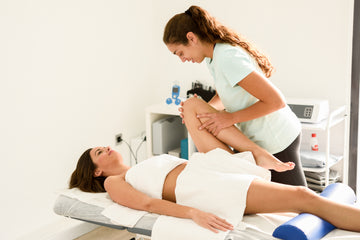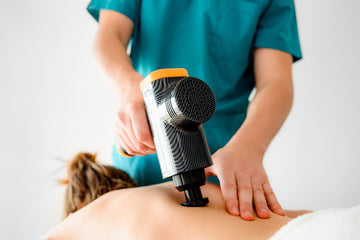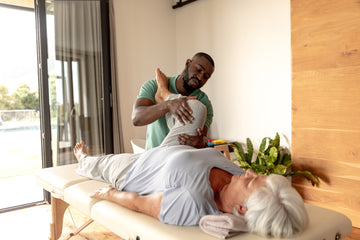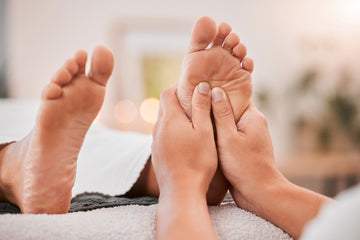The body’s musculoskeletal system is responsible for the body’s movement, support, protection, heat generation, and blood circulation. It is made up of bones, muscles, joints, tendons, ligaments, connective tissues, and more. When the body’s musculoskeletal system is strained, it can result in aches and pains in the muscles, joints, and other areas requiring physical therapy and massage to work out the kinks and bring relief from the pain.
How Physical Therapy and Massage Complement Each Other
The primary goal of physical therapy and massage is to relieve muscle tension, aches, pains, and spasms – but you may wonder how two seemingly different activities can complement each other.
Physical therapy focuses on diagnosing and treating musculoskeletal conditions and injuries through exercises, stretches, and hands-on techniques performed by a licensed physical therapist.
Massage therapy, on the other hand, involves manipulating muscles and soft tissues to alleviate pain, reduce stress, promote relaxation, improve circulation, and enhance overall well-being through skilled touch and techniques.
When combined, massage and physical therapy can address a wide range of conditions more effectively. Some of the conditions and ailments where massage and physical therapy can complement each other are:
- Acute and chronic sports injuries: Athletes often benefit from the combined approach of physical therapy and massage for acute and chronic sports injuries. Physical therapy helps in rehabilitation by improving strength, flexibility, and function, while massage aids in reducing muscle soreness, improving circulation, and preventing scar tissue formation.
- Chronic pain: Individuals with chronic pain conditions such as fibromyalgia, arthritis, or back pain can find relief through a combination of physical therapy and massage. Physical therapy targets the root cause of the pain, while massage provides temporary relief by relaxing muscle tension and improving blood flow.
- Post-surgery recovery: Physical therapy is essential for regaining mobility and strength after surgery. Massage can complement this by reducing post-operative swelling, relieving muscle tension, and improving overall comfort.
- Stress and anxiety: Stress and anxiety can lead to muscle tension and pain. Anxiety massage is best known for its relaxation benefits, which can be integrated into a broader wellness plan. By combining relaxation techniques with physical therapy to address these conditions' physical and mental aspects, individuals can find a deeper state of relief.
Benefits of Combining Physical Therapy and Massage
The combination of physical therapy and massage can be highly beneficial and aid in the body’s healing process. By integrating massage and physical therapy techniques, individuals can experience faster recovery times, increased range of motion, reduced pain, and a reduction in stress levels.
- Enhanced healing: Combining massage and physical therapy can accelerate the healing process by addressing both the structural and soft tissue aspects of an injury or condition.
- Improved range of motion: Physical therapy focuses on improving joint mobility and flexibility, while massage can help relax tight muscles and release fascial restrictions, collectively improving your range of motion.
- Pain reduction: The relationship between physical therapy and massage is particularly effective at reducing pain. Physical therapy addresses the underlying causes, while massage provides immediate relief by targeting tense muscles.
- Stress reduction: Massage therapy's relaxation benefits can alleviate stress and anxiety, which, when combined with physical therapy, can create an environment conducive to healing.
Timing Massage and Physical Therapy Sessions
To get the most out of massage and physical therapy sessions, timing is everything. Coordinating your massage and physical therapy session isn’t just about what works best in your schedule but how to maximize the benefits of each session. There are two approaches that yield results – pre-physical and post-physical therapy massages. Communication between you and your healthcare provider can help determine whether you should utilize massage before or after your physical therapy session.
Pre-Physical Therapy Massage
Some individuals benefit from receiving a massage session before their physical therapy appointment. Massage before a physical therapy session can help relax muscles, improve blood flow, and make it easier for the physical therapist to work on the affected area. However, this may not be suitable for everyone, especially if the massage is too relaxing, potentially reducing energy levels and making it difficult to perform physical therapy exercises.
Post-Physical Therapy Massage
In most cases, the most common time to receive a massage is after a physical therapy session. By waiting, massage can help alleviate muscle soreness or tension that may result from the exercises and hands-on techniques used by the physical therapist. Different types of massage can also help to promote relaxation, enhancing the overall therapeutic experience of combining the two techniques.
How to Support Using Massage and Physical Therapy Together
To enhance the combination of massage and physical therapy, the use of products and equipment can be used. When paired with physical therapy and massage, they create a more rewarding experience – helping you get the most out of your sessions.
- Partner massage – Having a trusted partner or family member learn how to give a good back massage at home can provide ongoing relief between professional massage sessions.
- Massage therapist – Regular sessions with a licensed massage therapist can target specific areas of concern and provide expert guidance on self-care practices.
- Massage/vibration gun – These handheld devices can be used to perform self-massage and alleviate muscle tension. They are particularly helpful for targeting trigger points and tight knots.
- Massage chair – Investing in a quality massage chair can provide daily relief for muscle tension and promote relaxation. These chairs offer different massage techniques and various benefits of an at home massage without needing to leave the comfort of your own home to visit a massage therapist.
Additional types of products or equipment include foam rollers, massage balls, and stretching aids which can make self-administered massage therapy easier at home.
Combining Physical Therapy and Massage for Relief
Relief from aches, pains, and strains can be achieved by attending physical therapy and massage sessions – but when you combine the two, the benefits of both can be enhanced. Adding additional products and equipment to the mix, like massage chairs, can bring added relief between sessions without leaving the comfort of your home.
Whether you're an athlete recovering from an injury or an individual seeking relief from chronic pain, the combination of massage and physical therapy can be a powerful path toward improved health and overall well-being.
Disclaimer: This content is not medical advice. Please consult with your health care professional when considering implementing changes to your health or workout routines to ensure it’s compatible with your needs.





